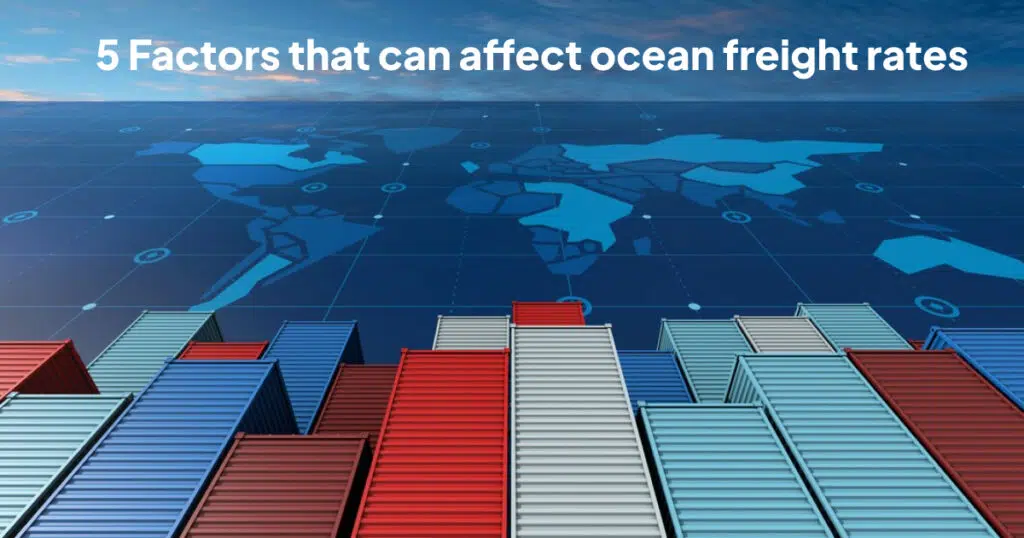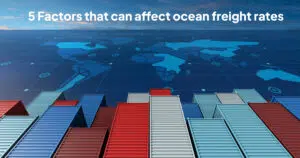Ocean freight continues to be the backbone of global trade, transporting commodities across continents and linking far-flung markets. The cost of shipping products by water changes due to a variety of reasons. Understanding these characteristics is critical for international trade businesses and individuals. In this detailed article, we’ll look at the five main elements that influence ocean freight pricing.
Energy Costs and Fuel Prices
Fuel prices have a significant impact on maritime freight rates. Ships primarily use heavy fuel oils, and fluctuations in crude oil prices have a direct impact on transportation expenses. Shipping rates might rise or fall due to volatile oil markets, increasing overall logistics costs.
Furthermore, environmental restrictions requiring the use of cleaner fuels, such as low-sulfur alternatives, have increased the cost of shipping. Compliance with these laws mandates the use of more expensive fuel options, which has an additional impact on freight charges.
Crude oil price fluctuations have a direct impact on shipping costs. Because most vessels run on heavy fuel oils, fluctuations in oil markets can have a substantial impact on our clients’ transportation costs.
Dynamics of Supply and Demand
The basic economics of supply and demand are critical in establishing maritime freight prices. Rates tend to rise when demand for shipping space exceeds available capacity. Rates may fall during periods of oversupply as shipping companies compete for cargo to fill their vessels.
Seasonal variations and global economic situations also have a significant impact on demand. For example, during peak seasons such as the holiday season, demand for shipping increases, typically resulting in increased charges due to restricted capacity available.
The underlying economics of supply and demand have a significant impact on maritime freight rates. One Union Solutions understands how market variables can influence interest rates. Rates rise when demand exceeds available capacity. Rates may fall during periods of oversupply, affecting overall logistical costs.
Capacity and Utilisation of Vessels
Ship size and availability have a considerable impact on freight charges. Larger vessels provide economies of scale, lowering costs per container and possibly lowering freight rates. If these vessels are underutilized as a result of decreasing cargo volumes, shipping corporations may hike tariffs to preserve profitability.
Furthermore, vessel availability is critical. Congestion at ports, delays in loading/unloading, and unforeseen disruptions (such as the Suez Canal blockage) can diminish vessel availability, leading freight prices to rise due to increased demand for limited shipping space. The size and availability of vessels have a considerable impact on freight pricing.
Costs of Operations and Industry Regulations
Operational costs account for a sizable component of maritime freight pricing. The whole cost structure includes maintenance, labor, insurance, and compliance with tight industry requirements. Compliance with safety and environmental regulations, for example, involves investments that are ultimately reflected in freight rates.
Furthermore, geopolitical events and governmental shifts can disrupt trade routes or impose additional costs, influencing shipping rates. Tariffs, trade agreements, and penalties are also important factors in affecting the cost of shipping products across oceans.
Shipping rates are directly influenced by geopolitical events, policy changes, tariffs, and trade agreements.
Infrastructure and Technological Progress
Technological advancements and infrastructure upgrades have a direct impact on ocean freight pricing. Port efficiency, improved terminal facilities, and streamlined logistics operations minimize turnaround times and costs, potentially resulting in lower freight rates.
Similarly, improvements in vessel design and propulsion systems targeted at increasing fuel efficiency and lowering emissions can have an impact on rates. Industry investments in digitization and automation can optimize operations, potentially mitigating some cost variables and indirectly influencing freight prices.
Conclusion:
Ocean freight rates are influenced by a plethora of complex factors, including economic, environmental, and geopolitical issues. Understanding these characteristics enables organizations to negotiate the intricacies of global trade and make smart logistics and supply chain management decisions.
As the dynamics of international commerce continue to change, stakeholders in businesses depending on ocean shipping must stay informed of these driving forces. Businesses may optimize their shipping strategy and reduce the impact of variable freight rates on their bottom line by understanding and adjusting to these shifting aspects. One Union Solutions will help you to understand these things.
FAQs
1: How do changes in fuel prices affect our shipping costs?
We at One Union Solutions understand that variations in crude oil prices have a direct influence on our clients’ shipping expenses. Because heavy fuel oils power the majority of vessels, changes in oil markets have a substantial impact on expenses, ultimately influencing freight rates.
2: What effect does seasonal demand have on freight rates?
Understanding seasonal swings is critical. Peak seasons, such as the holiday season, sometimes result in higher delivery charges due to restricted capacity availability.
3: How does the size of the vessel affect shipping costs?
We understand the significance of vessel size in terms of economies of scale. Larger ships lower per-container costs, potentially lowering freight rates. However, underutilized boats due to decreasing cargo volumes may force shipping companies to raise rates in order to remain profitable.
4: What impact do geopolitical events have on freight rates?
Shipping rates can be strongly influenced by geopolitical events and regulatory changes. One Union Solutions is watchful, anticipating and responding to these changes in order to minimize their influence on the freight expenses of our clients.







